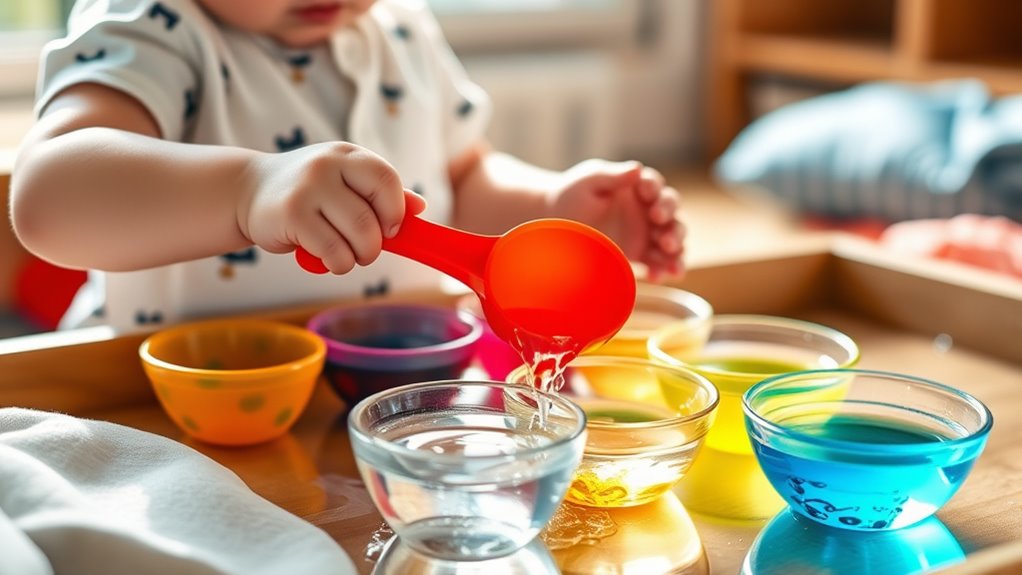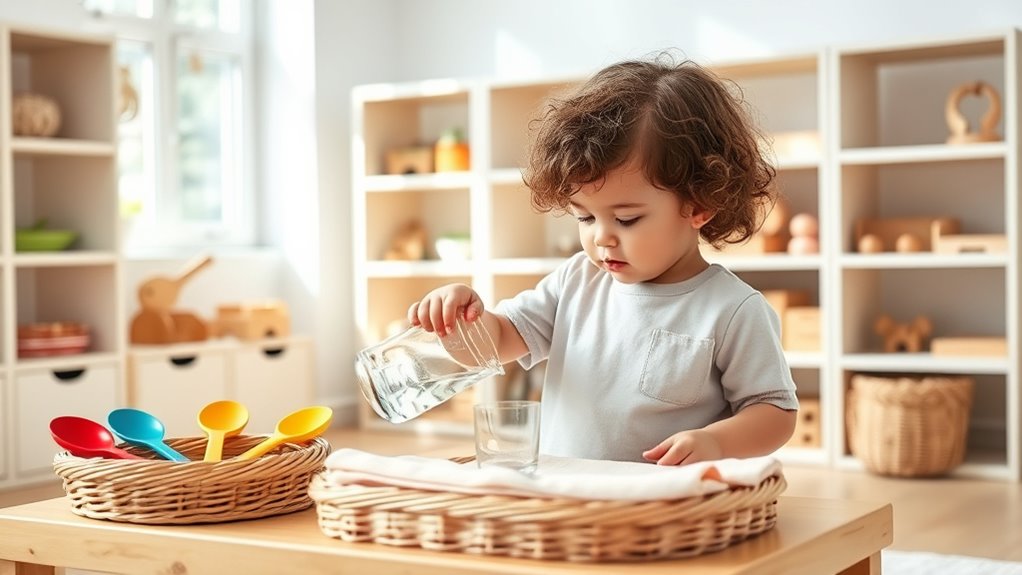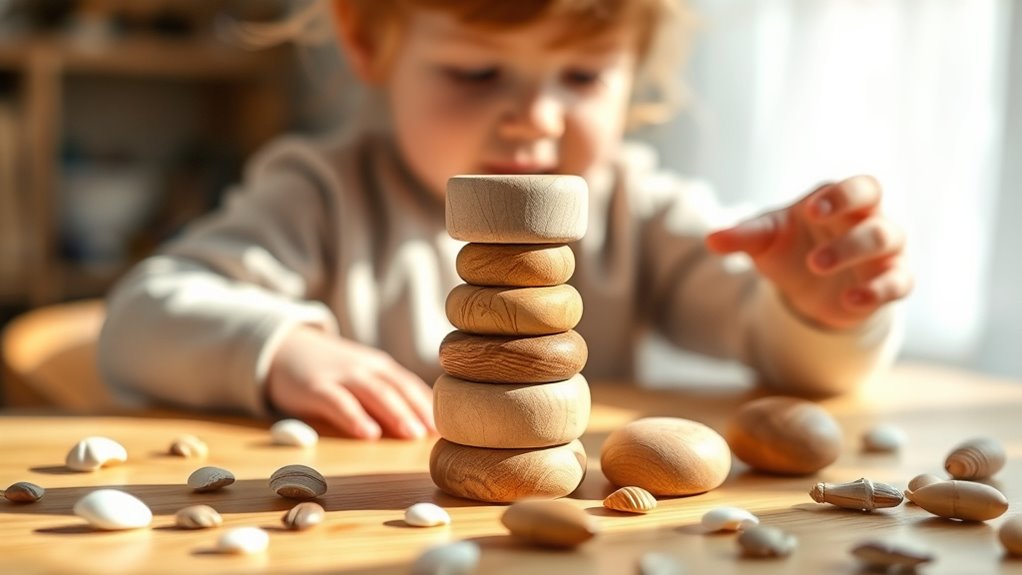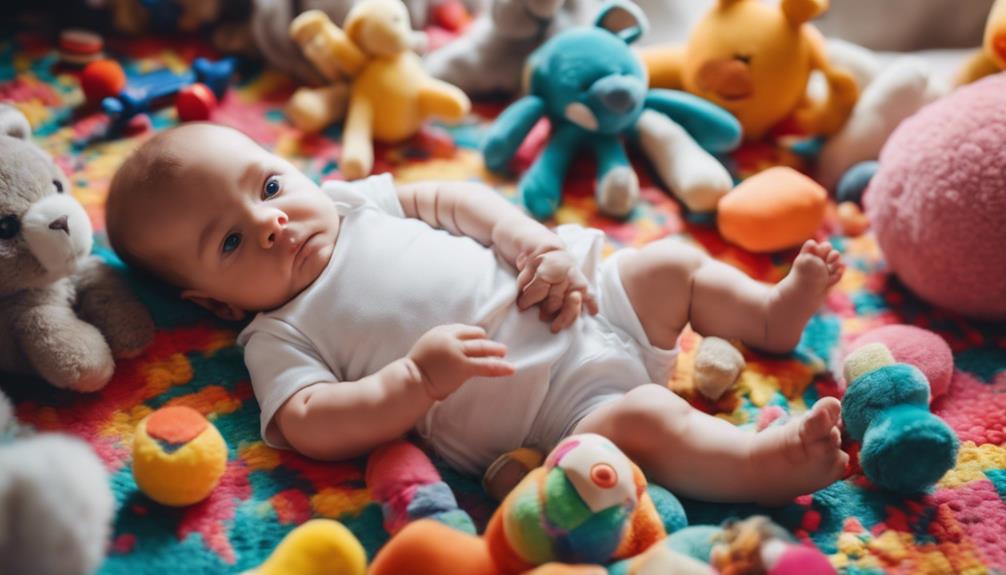To support your 2-year-old at home, try engaging in simple Montessori-inspired activities like sorting and matching objects, water play, and outdoor explorations. Incorporate practical life skills such as pouring or dressing routines, and encourage creative expression with art projects and music. Natural materials for stacking and building help develop fine motor skills, while outdoor activities foster curiosity about nature. Keep exploring these methods to discover more ways to guide your child’s growth and learning.
Key Takeaways
- Incorporate sensory and fine motor activities like sorting, water play, and art projects to develop coordination and problem-solving skills.
- Use practical life routines such as dressing, pouring, and table setting to promote independence and confidence.
- Engage in outdoor exploration through planting, leaf collecting, and nature observation to foster curiosity and environmental awareness.
- Incorporate music and movement activities with instruments and dance to enhance motor skills, rhythm, and emotional expression.
- Create a safe, engaging environment with natural materials, artistic supplies, and sensory play to support holistic development at home.
Simple Sorting and Matching Games

Simple sorting and matching games are excellent ways to develop your toddler’s cognitive and fine motor skills. These activities help your little one practice color recognition and shape matching, essential early learning skills. You can create simple games using everyday objects like colored blocks or shape puzzles. Encourage your toddler to sort items by color or match shapes to corresponding outlines. As they pick up and place objects, their hand-eye coordination improves. Keep the activities fun and manageable, offering praise for their efforts. These games foster concentration, problem-solving, and visual discrimination. Plus, they’re easy to set up at home with materials you already have. Consistent practice helps solidify your child’s understanding of colors and shapes, laying a strong foundation for future learning. Incorporating educational wooden toys can further enhance these skills by providing durable and safe options for repeated play. Additionally, choosing age-appropriate toys ensures safety and promotes effective skill development. Understanding the importance of early childhood development can guide you in selecting activities that support your child’s growth. Using sensory toys during these activities can stimulate tactile exploration and deepen learning engagement. Engaging in these activities regularly also aligns with principles from the Law of Attraction, encouraging positive reinforcement and a growth mindset in your child’s learning journey.
Water Play and Sensory Buzzles

Have you ever noticed how water and sensory buzzles captivate your toddler’s attention? Water play offers a wonderful opportunity for liquid experiments that develop curiosity and fine motor skills. Fill a shallow basin with water and add cups, droppers, or small toys to encourage pouring, splashing, and exploring. Kids love creating foam bubbles by adding a bit of dish soap or bubble solution, which sparks visual and tactile senses. These activities promote sensory development and concentration without any mess. As your child dips their hands into water or watches bubbles form and pop, they learn about cause and effect naturally. Incorporating safe and non-toxic materials ensures that your toddler can explore freely without concerns. Using appropriate lighting conditions can also enhance the visual appeal and engagement of water activities. Incorporating a variety of sensory experiences can further stimulate your child’s curiosity and learning during water play. Keep the activities simple and safe, and watch your toddler delight in the endless sensory buzzles of water play.
Practical Life Skills With Everyday Items

Building on your child’s fascination with water and sensory buzzles, introducing practical life skills using everyday items helps them develop independence and coordination. You can encourage dressing routines by allowing your child to practice buttoning, zipping, or pulling on socks and shoes. These simple tasks build motor skills and confidence. Incorporate table manners by involving them in setting and clearing the table, using utensils, and pouring water or juice from small bottles. These activities teach patience, responsibility, and social skills. Keep tasks short and manageable, providing gentle guidance. As your child masters these routines, they’ll gain autonomy and feel proud of their achievements, setting a foundation for more complex skills later on. Shower fixtures and accessories also serve as practical tools for teaching children about maintenance and cleanliness in a fun, engaging way. Additionally, demonstrating how to operate bathroom fixtures safely can foster independence and understanding of personal hygiene routines. Recognizing child-safe cleaning tools can further enhance their understanding of cleanliness and safety in everyday routines. To further support their motor development, you might introduce simple activities like turning faucets on and off to build hand strength and coordination related to inflating Presta valve tires, which also requires fine motor skills. Moreover, exploring different candle making techniques like wickless or wax-free methods can serve as a creative project that enhances their fine motor control and understanding of materials.
Nature Exploration and Outdoor Activities

Introducing your 2-year-old to nature exploration and outdoor activities offers endless opportunities for discovery and learning. You can start with simple garden planting, letting your child dig, plant seeds, and water the plants. This hands-on activity teaches responsibility and patience while fostering curiosity about growth. Take your child on leaf collecting adventures, encouraging them to gather different shapes, sizes, and colors of leaves. Talk about the textures and patterns, helping them develop observation skills. Outdoor play also boosts physical development, coordination, and sensory awareness. Keep activities short and engaging, and always supervise closely. These experiences not only connect your child with nature but also lay a strong foundation for a lifelong love of the outdoors. Be mindful of the odors associated with outdoor activities, as strong scents like bleach or spoiled food can sometimes be present and should be avoided during play. Additionally, understanding the history of outdoor play can inspire new ways to engage your child in natural environments. Incorporating elements like nature-based sensory activities can further enhance their engagement and learning. To enrich their outdoor experience, consider introducing age-appropriate outdoor educational toys that promote curiosity and exploration.
Fine Motor Skill Development With Art Projects

You can help your child develop fine motor skills through simple art projects like creative painting activities. Incorporate threading and lacing exercises to improve hand-eye coordination and dexterity. These activities make skill-building fun and engaging for your little one. Incorporating visualization techniques can further personalize activities to match your child’s developmental pace, making learning even more effective. Additionally, choosing age-appropriate developmentally suitable materials ensures safety and encourages confidence during these creative tasks. Using high-quality filters and proper air quality management in your home can also create a healthier environment for your child’s overall development. Understanding child development stages can help tailor activities to suit your child’s evolving abilities.
Creative Painting Activities
Have you ever wondered how simple painting activities can boost your toddler’s fine motor skills? Creative painting activities like finger painting help develop their hand muscles and coordination. Let your child explore color mixing by providing primary colors and encouraging them to blend paints with their fingers. This not only fosters creativity but also enhances their ability to grasp and manipulate tools. As they dip their fingers into paint and make broad strokes, they practice grasping, pinching, and controlling movements essential for writing later on. Keep the activity simple and safe, using washable paints and large sheets of paper. These hands-on experiences make art engaging while simultaneously strengthening their fine motor skills and encouraging sensory exploration.
Threading and Lacing Exercises
Threading and lacing exercises are excellent ways to strengthen your toddler’s fine motor skills through engaging art projects. You can introduce threading beads, which help your child practice hand-eye coordination and improve dexterity. Use large, colorful beads that are easy for small hands to grasp and thread onto a string or shoelace. Lacing cards are another fantastic tool; they feature holes that your toddler can practice threading with thick, sturdy laces. These activities enhance concentration and develop bilateral coordination as your child manipulates the string and beads or laces. Keep the materials simple and safe, and encourage your toddler to experiment with different patterns. Regular practice with threading beads and lacing cards will boost their fine motor control while having fun creating colorful, textured art projects.
Building and Stacking With Natural Materials

Using natural materials like stones, sticks, and shells provides a rich sensory experience for 2-year-olds, encouraging them to explore and develop their fine motor skills. As they build and stack, you can introduce concepts of environmental conservation by explaining how these materials come from nature and should be kept safe. This activity also fosters cultural awareness, as children may notice different shapes, colors, and textures from various environments. Encourage them to create towers or patterns, promoting concentration and problem-solving. Handling natural objects gently teaches respect for nature, reinforcing sustainable practices. Through stacking and building, your child not only improves hand-eye coordination but also begins to understand the importance of caring for the environment and appreciating diversity in the world around them.
Music and Movement for Active Learning

Why is music and movement such an essential part of active learning for 2-year-olds? It helps develop their motor skills, sense of rhythm, and coordination. Engaging in rhythm and dance allows your child to express emotions while improving muscle control. Using musical instruments, like shakers or drums, encourages them to explore sound and understand cause and effect. Moving to music boosts their balance and spatial awareness, making learning fun and dynamic. You can play simple songs and invite your child to dance, clap, or tap along. This hands-on approach nurtures their creativity, listening skills, and confidence. Incorporating music and movement into your daily routine creates joyful moments and supports their overall development in an engaging way.
Frequently Asked Questions
How Can I Adapt Montessori Activities for Limited Indoor Space?
To adapt activities for limited indoor space, focus on indoor space optimization by choosing compact, multi-use furniture and organizing clutter. Use portable activity options like foldable mats, small trays, or baskets to create versatile learning zones. You can also incorporate activities that require minimal space, such as stacking, sorting, or simple sensory play. These strategies help you maximize your space while providing engaging Montessori-style activities for your 2-year-old.
What Safety Precautions Should I Consider During Water Play Activities?
It’s interesting how water play can unexpectedly spark joy and learning. When you set up water activities, prioritize water safety by never leaving your child unattended. Keep a close eye on them, and use non-slip mats to prevent falls. Follow supervision tips like controlling water depth and ensuring all materials are age-appropriate. This way, your little one can explore safely while building confidence and fine motor skills.
How Do I Encourage Language Development Through These Activities?
To encourage language development during water play, engage your child with simple words and descriptive phrases to support their language milestones. Talk about what they’re doing, like “pour,” “splash,” or “big,” to boost vocabulary building. Ask questions and encourage them to repeat words, fostering active participation. Your enthusiasm and interaction help your child connect words with actions, making learning fun and effective.
What Are Signs of Readiness for More Complex Activities?
Signs of readiness for more complex activities shine through your child’s child-led exploration and growing attention span indicators. When they enthusiastically engage, focus longer, and independently select activities, it’s time to tempt them with slightly more challenging tasks. Watch for their willingness to wait, follow multi-step instructions, and demonstrate curiosity beyond basic play—these signals show they’re stepping into their next learning level, ready for the next adventure.
How Can I Involve Siblings or Other Children in These Activities?
You can involve siblings or other children by encouraging group play, which fosters social skills and teamwork. Set up shared activities that promote sharing skills, like building blocks or art projects, where everyone works together. Guide them to take turns and communicate, making the experience enjoyable and educational. This approach helps children learn cooperation and patience, enhancing their development while creating a fun, inclusive environment for all involved.
Conclusion
As you explore these activities, you might find yourself amazed at how effortlessly your little one learns, almost like the toys and nature conspire to teach them. Bright colors, gentle water splashes, and the rustle of leaves become part of your daily routine, turning ordinary moments into magical learning experiences. With each activity, you’ll see your child’s curiosity bloom, reminding you that sometimes, the simplest activities create the most wonderful discoveries at home.










